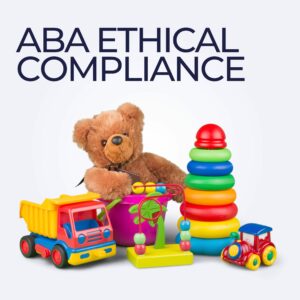Navigating the Ethics of ABA
Table of Contents
Imagine a world where every professional decision you make impacts someone’s life directly. In the field of Applied Behavior Analysis (ABA), this is a daily reality, where ABA ethical compliance is not just about following rules; it’s about ensuring the welfare, dignity, and progress of the individuals we serve. The Behavior Analyst Certification Board (BACB) provides a compass in the form of its Professional and Ethical Compliance Code, which is more than a set of guidelines – it’s the backbone of ethical practice in ABA.

The Significance of the BACB's Compliance Code
The BACB’s Professional and Ethical Compliance Code is more than a document; it’s a commitment to excellence and integrity in the field of ABA. Its significance lies in its role as a guardian of ethical practice, safeguarding not only clients but also the reputation and effectiveness of the ABA profession. This code offers clarity in complex situations, ensuring that every decision is effective and morally sound.
Key Principles of the Code
At the heart of the code are key principles that guide behavior analysts in their professional conduct. These principles include:
- Responsibility to Clients: Ensuring clients’ best interests are at the forefront of all decisions.
- Professionalism: Upholding high standards of professional behavior.
- Integrity: Being truthful and honest in all professional interactions.
- Confidentiality: Protecting the privacy and rights of clients.
By adhering to these principles, behavior analysts navigate the challenging landscape of human behavior with a moral compass, ensuring that their work changes behavior and respects the individuality and rights of those they serve.
Responsibility to Clients
This section of the code is paramount. It emphasizes the need for behavior analysts to prioritize their clients’ welfare and best interests above all else. This includes obtaining informed consent, ensuring confidentiality, and practicing within their scope of competence. By doing so, behavior analysts create a safe and respectful environment conducive to learning and growth.
Professionalism and Integrity
Professionalism and integrity are the bedrock of trust in any therapeutic relationship. The BACB’s code outlines clear expectations for behavior analysts to conduct themselves professionally. This includes maintaining accurate records, avoiding conflicts of interest, and representing their qualifications honestly. These integrity standards protect clients and enhance the credibility and trustworthiness of the ABA profession.
Navigating Ethical Dilemmas
The path of an ABA professional is often marked with complex ethical dilemmas. These can range from conflicts of interest to balancing client confidentiality with the need to report critical information. The BACB’s code provides a framework for resolving these dilemmas, encouraging behavior analysts to evaluate each situation critically, consult with colleagues, and prioritize the well-being of their clients. Understanding and applying this ethical framework is key to maintaining the profession’s integrity and ensuring the best outcomes for those under our care.
Practical Insights: Navigating Ethical Dilemmas in ABA
In the nuanced and often challenging Applied Behavior Analysis (ABA) world, practitioners are regularly confronted with situations that test their ethical compass. These scenarios, known as ethical dilemmas, require careful navigation to ensure decisions align with the Behavior Analyst Certification Board’s (BACB) Professional and Ethical Compliance Code. Understanding how to handle these dilemmas is crucial for maintaining the profession’s integrity and our client’s well-being.
The following examples illustrate common ethical dilemmas that ABA professionals may encounter in their practice. Accompanying each scenario is guidance derived from the BACB’s code, providing a roadmap for ethical decision-making. These examples aim not only to shed light on how to approach such situations but also to reinforce the importance of adhering to ethical principles in every aspect of ABA practice.
Ethical Dilemma 1: Dual Relationships
Situation: You’re an ABA therapist, and the parent of a client asks if you can babysit their child on weekends. This situation poses a risk of a dual relationship, where your professional and personal roles may conflict.
BACB Guidance: The BACB’s code advises against engaging in dual relationships that could impair professional judgment or increase the risk of exploitation. In this case, you should politely decline the babysitting request, explaining that maintaining a professional boundary is crucial for the effectiveness and integrity of the therapy.
Ethical Dilemma 2: Confidentiality with Risk of Harm
Situation: During a session, a client reveals information about potentially harmful behavior they’re engaging in at home, which they have not disclosed to their parents.
BACB Guidance: While maintaining confidentiality is important, the BACB’s code emphasizes the need to prioritize client welfare. If the behavior poses a risk of harm to the client or others, you are ethically obliged to take appropriate steps, which may include informing the parents or authorities while ensuring the least amount of harm and respecting the client’s privacy as much as possible.
Ethical Dilemma 3: Ineffective Treatment
Situation: You are implementing an ABA program designed by a supervising BCBA, but you observe no progress in the client, and the client seems increasingly frustrated.
BACB Guidance: The BACB’s code stipulates the responsibility to advocate for and use effective treatments. In this case, discussing your observations with the supervising BCBA and suggesting reassessing the treatment plan would be appropriate. It’s essential to use data-driven approaches and modify plans when they are not yielding the expected outcomes.
Ethical Dilemma 4: Conflicting Directions from Family Members
Situation: The parents of a client you work with are divorced and give conflicting instructions about the child’s ABA therapy.
BACB Guidance: According to the BACB’s code, the primary commitment is to the client’s well-being. In situations of conflicting directives from family members, the therapist should seek clarification, possibly involve a mediator, and focus on the therapeutic goals aligned with the client’s best interests. Documentation and communication with all parties involved are crucial.
Ethical Dilemma 5: Pressure to Overstate Progress
Situation: Your employer pressures you to report more progress than has actually occurred to continue receiving funding for a client’s therapy.
BACB Guidance: The BACB’s code mandates integrity and honesty in all professional activities. Fabricating or overstating progress is unethical. In this situation, it’s important to report accurately, regardless of external pressures. If necessary, seek guidance from an ethics board or a legal advisor.
These examples illustrate how ABA professionals can navigate complex situations ethically. Adhering to the BACB’s Professional and Ethical Compliance Code is paramount in ensuring that decisions made are in the clients’ best interests and uphold the integrity of the ABA profession.
The Impact of Ethics on ABA Practice
Ethical practice in ABA isn’t just about avoiding harm but actively doing good. Adherence to the BACB’s ethical code profoundly impacts the effectiveness of ABA interventions. It builds trust between clients and practitioners, fosters a positive therapeutic environment, and ensures that interventions are not only effective but also respectful and dignified. This commitment to ethics elevates the entire field, bolstering its reputation and efficacy.
Embracing Ethical Practice in Everyday ABA
The BACB’s Professional and Ethical Compliance Code is not just a document to be referenced in times of uncertainty or conflict; it should be an integral part of everyday practice for ABA professionals. By internalizing and applying these principles consistently, behavior analysts can ensure they are compliant and champions of ethical practice.
The Role of Collaboration and Supervision
Ethical practice in ABA is not a solitary endeavor. It thrives on collaboration and supervision. Regular consultations with supervisors and peers about ethical concerns can provide valuable insights and different perspectives, leading to more informed and ethical decision-making. This collaborative approach ensures a culture of ethical mindfulness within the ABA community.
ABA Ethical Compliance: Life Long Journey
The journey through the landscape of ethics in ABA, guided by the BACB’s Professional and Ethical Compliance Code, is one of continuous learning, reflection, and application. It’s a path that demands vigilance, compassion, and a deep commitment to doing what is right for our clients and the profession. As behavior analysts, our adherence to these ethical standards defines our professional identity and reflects our dedication to making a meaningful, positive impact in the lives of those we serve.
Ethics in ABA is not just about following a code; it’s about embodying the spirit of respect, integrity, and professionalism in every action we take. Let’s commit to this ethical journey together, upholding the highest standards and making a real difference in the world, one ethical decision at a time.
FAQ Section
Q: How often is the BACB’s ethical code updated?
A: The BACB regularly reviews and updates its ethical code to reflect the evolving nature of the field and societal norms. It’s crucial for practitioners to stay informed about these updates.
Q: Are there any resources for additional ethical training for ABA professionals?
A: Yes, there are numerous resources available, including online courses, webinars, and workshops focused on ethical practice in ABA. Many of these are offered by professional organizations and accredited institutions.
Q: How does the BACB enforce its ethical code?
A: The BACB enforces its ethical code through a formal review process. Complaints regarding ethical violations are assessed, and if a violation is found, disciplinary actions, ranging from reprimands to revocation of certification, can be taken.
Q: What are the consequences for violating the BACB’s ethical code?
A: Consequences can include reprimands, mandatory training, suspension, or even revocation of certification, depending on the severity and nature of the violation.
Q: Can clients and families provide input or feedback on ethical practices?
A: Absolutely! Feedback from clients and families is crucial. It helps ensure that practices remain client-centered and ethically sound. Many ABA providers have formal mechanisms for receiving and addressing such feedback.
Resources for Reporting
BACB’s Website: The BACB provides detailed instructions and forms for reporting ethical violations. Visit BACB’s official website for the most current resources and guidelines.
Ethics Reporting Form: The BACB has an Ethics Reporting Form available on their website. This form is designed to guide you through the process of filing a report and ensures that you provide all necessary information.
Consultation with Peers or Supervisors: If you’re unsure about whether a situation constitutes an ethical violation, consult with a colleague, supervisor, or an ethics board. Sometimes, discussing the matter with experienced professionals can provide clarity and guidance.
Confidentiality and Protection
The BACB takes confidentiality seriously. The identity of the person reporting and the details of the report are kept confidential to the extent possible. It’s important to report ethical violations to protect clients, maintain professional standards, and uphold the integrity of the ABA field.



